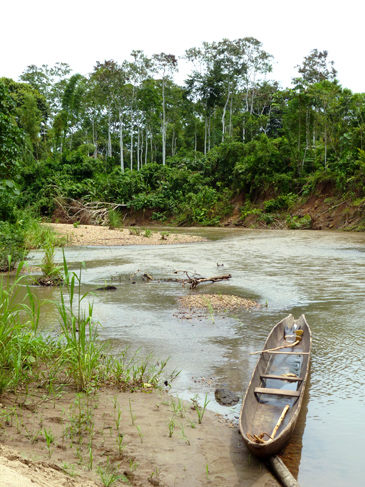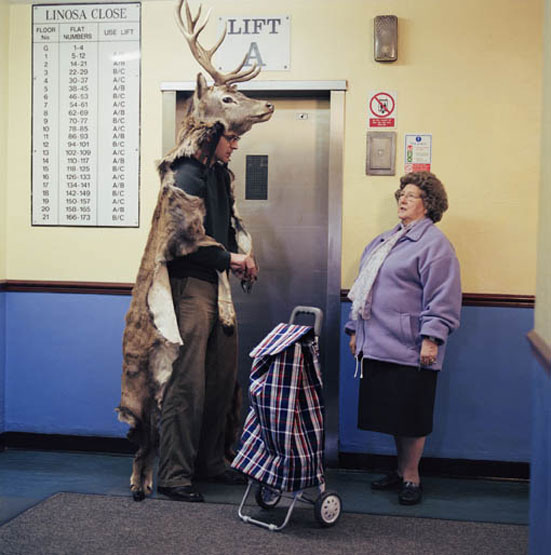
Marcus Coates, "The Trip," 2010. Documentary photograph. Courtesy the artist.
All travel is retrospective. We don’t travel for the experience – most traveling time is spent waiting, after all – but in order to have something to remember. The easy editing abilities of digital photography have transformed utterly the modern idea of travel. It’s all peaks, no troughs: the past perfect. Journeys only really exist once they’ve finished, and every story starts at the end.
The Trip is a 35-minute film by the artist Marcus Coates that consists of two long, still shots of the same thing: the interior of a room in a hospice in north west London. You see a flat-screen TV, a wall-lamp, and a window giving onto a quiet suburban road. In one of the shots, the day’s color drains, barely perceptibly, from the sky. In the other, the morning’s light is still, steady, the sky windless. Unseen between the two shots, each one lasting the duration of a dialogue heard on the soundtrack, is the event of the title: a trip to the Amazonian rainforest, which is discussed in voiceover in both parts of the film. The disparity — both comic and poignant — of what’s seen and heard is part of the point. The trip, undertaken by the artist, is plotted in the first section and recounted in the second. Nothing of the trip itself is shown: it happens in the two men’s dialogue and in the mind of the viewer. The trip was proposed by one of the men, a terminally ill man named Alex H., and was carried out and described by the artist.
Film is a proxy medium: I went here so you didn’t have to. The appetite for seamy subject matter in everything from Caravaggio to Nan Goldin to The Wire is part of what we want from art: a vicarious trawl through experiences we ourselves would never deign or dare to have. Coates’s film extends the idea further: I went here because you couldn’t. In The Trip, Coates repositions the artist as a shamanic figure, someone able to transmit information from another world for the benefit of this one. It’s a theme in much of his work: in Journey to the Lower World, he “channeled” animal spirits to the residents of a block of flats in Liverpool by dressing himself in a deer skin and imitating animal calls. The Plover’s Wing, similarly, had the artist cooing his impression of the bird to an unimpressed Israeli mayor, while wearing a dead badger on his head. Coates’s art flirts with the ridiculous – is ridiculous, at times – but it’s through his ability to exploit the liberating power of embarrassment that his art attains its uncanny beauty. His film Dawn Chorus – viewable more or less in its entirety on YouTube, and worth five minutes and forty seconds of your time – shows sped-up footage of humans imitating birdsong, while sitting in various working and domestic environments, having learned slowed-down imitations of different calls. It’s funny, and Coates’s art is genuinely funny, but the laughter it provokes is what Tom Stoppard calls “the sound of comprehension.” We recognize something.

Marcus Coates, "Journey to a Lower World," 2004. Performance still. Courtesy the artist, photo by Nick David.
Coates is consistently referred to as “eccentric,” but it’s a misnomer — it’s impossible to be genuinely eccentric in contemporary art — and its use renders his work merely wacky or madcap, which it never is. And while his work has something in common with other contemporary British artists working in a wilfully oddball manner, like Nathaniel Mellors and Spartacus Chetwynd, with both of whom Coates has been shown (and with whom he shares an interest in narrative, diversity of media, and the folkloric roots of the modern world), Coates is a more deliberately outward-focused artist. The audience is at least as important as the artist and his work: the strength of a work like Dawn Chorus comes in the participants’ willingness to appear ridiculous to access something approaching the sublime. The Trip, produced during the artist’s residency in St John’s Hospice, is a condensation of the same principle: in it, the artist becomes a tool for the audience, a means by which the audience member might channel his or her desires.
In the first part of The Trip, Alex is asked by Coates, “What can I do for you?” Alex’s request is to fulfill a lifelong ambition his ill-health now prevents him from being able to carry out: a trip to the Amazon. Their dialogue, heard over the soundtrack as cars crawl up and down the road outside, lays out the parameters of the trip. Coates is asked to ask questions of the native people: what do they think of us? What’s their experience of life like? What are their values? Coates listens intently. Alex admits that he doesn’t know what it’ll do for him, what the point is. He shrugs off Coates’s suggestion of bringing back a souvenir. The idea of someone doing something for him is enough.
By the time of the second section, Coates has returned. The identical nature of the second shot is a reminder of the diversity of experience the briefly blackened screen portends: for Alex, this has been his view throughout the duration of Coates’s trip. Coates tells his story while Alex asks eager questions, sometimes interrupting the tale, probing for finer details. Traveling in a tiny biplane, Coates accessed the jungle from above, and he describes the impossible vastness of the landscape. “I can well imagine,” says Alex. He encounters a vast, white tree native to Ecuador he initially took as dead. “Gosh,” says Alex. He meets members of a native tribe and has a conversation with an elderly woman through two translators. “I can picture it,” says Alex. He records a song – “it’s about life and death,” says Coates – sung by a native man, which he then plays to Alex. The little room fills with the recorded voice, plaintive and guttural, as the two men sit silently and the cars slip along the road beyond. Both the tale and The Trip (and the tale is the trip) end with that sound and that sight.

Marcus Coates, "The Trip," 2010. Documentary photograph. Courtesy the artist.
The Trip is showing at the Serpentine Gallery, London, until May 3, 2011.



